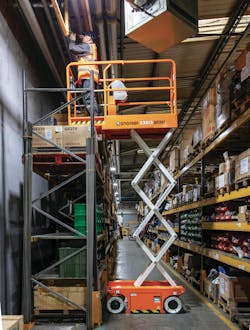Interview with Snorkel’s Nick Iannuccilli: Increased Adaptability
Nick Iannuccilli, project manager – marketing, Xtreme Manufacturing & Snorkel, talks about platform steps, the demand for larger MEWPs, the need for enhanced training, predictive maintenance, and more.
RER: What are the most important developments in mobile elevating work platforms in the past year - especially technology that would be of interest to rental companies?
Iannuccilli: In the past year, some of the biggest technology movements in the MEWP world have been focused on increased adaptability and access for existing machines. The industry push for additional, higher platform steps to gain a couple of extra feet into restrictive areas has led many manufacturers to respond with new options that allow greater platform height in a smaller footprint. Much of this demand is being driven by the rapid growth of data centers, which are appearing in large numbers and increasing rental activity.
What’s new in your company’s MEWP offering over the past year or so?
Iannuccilli: Snorkel recently launched a refined “Step-Up” option in its compact S3013M and S3220M scissor models. This feature allows additional platform height without the need for fall arrest systems but folds out of the way when full platform access is required. Snorkel increased the capacity of its established TB86J boom lift by introducing a tri-capacity restricted zone. This update permits up to 1,000 pounds of platform load in the restricted zone, along with 750 pounds in a less restricted area, providing customers with greater flexibility and building on one of the most reliable machines in the aerial work platform industry.
What are some of the most interesting applications for MEWPs that you’ve seen currently or over the past year or so?
Iannuccilli: A clear trend has been the demand for larger machines. When Snorkel launched the 2100SJ in early 2020, many questioned whether a machine of that size would ever be necessary. Since then, several new models have been introduced that exceed the 210-foot platform height benchmark, although none have surpassed the industry-leading 115 feet of horizontal reach.
Rental companies can all read the manufacturers instruction or IPAF “how to use” documents, and pass that documentation on to the customers, but what are some of the most important tips or suggestions for safety on aerial equipment that you would like to pass along to rental companies? What are the most common mistakes renters of aerial equipment make?
Iannuccilli: The importance of proper and thorough operator training cannot be overstated. When rental companies fail to emphasize this with their customers, unnecessary risks are created for the entire industry — from end users and site personnel to contractors, rental firms, and manufacturers. Every entity in the chain ultimately feels the repercussions of inadequate training. The goal should always be to ensure every employee returns home safely at the end of the day, and well-trained operators have the skills to make that happen.
Equally important is proper service training. Rental companies sometimes assume that mechanical skills automatically translate to proficiency with hydraulically operated lifting equipment. While the two disciplines overlap, aerial work platforms require specific training that many technicians lack. Without it, both timelines and operator safety are at risk. Fortunately, there are excellent hydraulic training courses available, and rental companies should take advantage of them to ensure their fleets are serviced correctly.
Looking ahead, what are the next new development or developments in aerial equipment technology? What are some developments you would like to see? What’s on the horizon?
Iannuccilli: Looking forward, it is no surprise that electrification will remain a headline topic in aerial equipment. While much has already been said, the next steps are not simply about bigger batteries. The industry needs smarter charging infrastructure and better integration into rental workflows.
What deserves more attention is predictive maintenance. Current telematics solutions typically provide location and operational status. The real opportunity is in predictive analytics — systems that can anticipate component wear or hydraulic issues before they occur. For rental companies managing large fleets, this shift will reduce downtime, improve jobsite productivity, and enhance safety. Aerial lifts are complex machines, and moving from reactive to predictive service will be a major advancement.
Another area that should be more central to industry discussions is design for serviceability. With skilled technicians in short supply, rental companies need machines engineered for fast and straightforward service. Modular components, built-in diagnostics, and commonality across product lines all help reduce downtime and training requirements. Future innovation should prioritize these serviceability features, ensuring fleets can stay on rent and operators remain productive.
About the Author
Michael Roth
Editor
Michael Roth has covered the equipment rental industry full time for RER since 1989 and has served as the magazine’s editor in chief since 1994. He has nearly 30 years experience as a professional journalist. Roth has visited hundreds of rental centers and industry manufacturers, written hundreds of feature stories for RER and thousands of news stories for the magazine and its electronic newsletter RER Reports. Roth has interviewed leading executives for most of the industry’s largest rental companies and manufacturers as well as hundreds of smaller independent companies. He has visited with and reported on rental companies and manufacturers in Europe, Central America and Asia as well as Mexico, Canada and the United States. Roth was co-founder of RER Reports, the industry’s first weekly newsletter, which began as a fax newsletter in 1996, and later became an online newsletter. Roth has spoken at conventions sponsored by the American Rental Association, Associated Equipment Distributors, California Rental Association and other industry events and has spoken before industry groups in several countries. He lives and works in Los Angeles when he’s not traveling to cover industry events.
